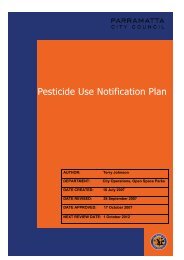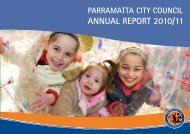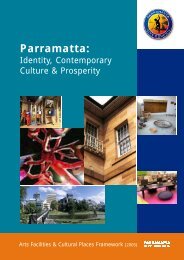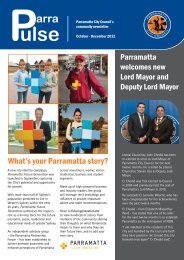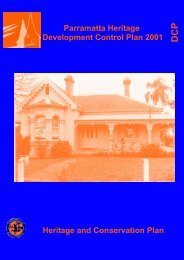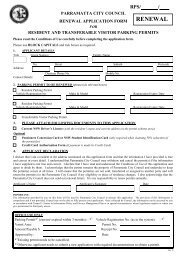Memory of Trees Exhibtion Publication - 2.7 MB - Parramatta City ...
Memory of Trees Exhibtion Publication - 2.7 MB - Parramatta City ...
Memory of Trees Exhibtion Publication - 2.7 MB - Parramatta City ...
Create successful ePaper yourself
Turn your PDF publications into a flip-book with our unique Google optimized e-Paper software.
Angus Geracitano, Mitchell Street, Ermington<br />
1992<br />
Photograph<br />
Courtesy <strong>of</strong> Danielle Geracitano<br />
24<br />
Letter from Frank Allport to his brother William<br />
From the Collection <strong>of</strong> the Mitchell Library<br />
State Library <strong>of</strong> New South Wales<br />
Even Henry Curzon Allport's family, a 19 th Century <strong>Parramatta</strong> family, had their<br />
special trees. Henry's son, Frank Allport, in a letter to his brother William,<br />
mentioned the gardens, in particular the cork tree in Hambledon Cottage. One <strong>of</strong><br />
the daughters <strong>of</strong> renowned painter Henry Curzon Allport (most likely, Bertha Betts<br />
Allport) kept a diary in 1877 which depicts, among other activities, her family’s daily<br />
interactions with trees. On one particular day, Bertha writes “Frank & I walked to<br />
‘tree’”. However on the following day, her visit to the tree changes from shared to<br />
private: “I walked to ‘tree’, by myself”. Did she desire contemplation and privacy,<br />
an escape from her large family (just like my mother, she shared a household<br />
with six siblings)? Or did she seek a cool place in the shade, to draw and paint<br />
her pictures? Imagine a solitary tree in <strong>Parramatta</strong> Park or along the banks <strong>of</strong> the<br />
<strong>Parramatta</strong> River; here you will find Bertha, sitting under her favourite tree.<br />
The Allport family cared for a collection <strong>of</strong> trees, and would pick fruit from these<br />
trees as a shared family ritual, just like in my childhood home. Each sibling had<br />
their role, as Bertha notes throughout her diary: “Frank at work at the Apricot<br />
<strong>Trees</strong>”, “Alice stewed plums for preserving”, “Clara & Flo picked nectarines”.<br />
However, unlike my leisurely experience <strong>of</strong> swinging on branches and hiding in<br />
tree-tops, the Allport family were dependant on their trees for survival. They<br />
lived <strong>of</strong>f the land, and to secure income they picked a variety <strong>of</strong> fruit to be sold in<br />
town, such as apricots, nectarines, oranges, passionfruit and bananas. In Bertha’s<br />
world, a valuable exchange with nature took place. With every stick she picked<br />
up from the garden to fuel the family’s fire, another tree was planted or cared for.<br />
The Allport family’s respect for nature can be seen as a lesson for our times – a<br />
reminder to replace what we take from our natural environment, and to care for<br />
what is already endangered or disappearing.<br />
I like to imagine that the olive tree is still in my childhood home, being looked<br />
after by another family, and that their children are climbing the branches that<br />
are so familiar to me. They would have their own stories about the tree, different<br />
from mine. In the meantime I will have to find a new tree. So hug your favourite<br />
tree, as you would a family member, while you still can.









